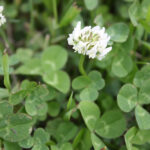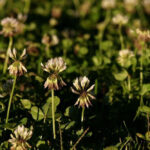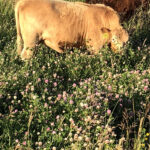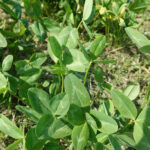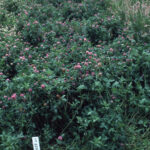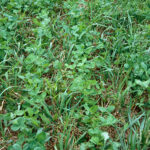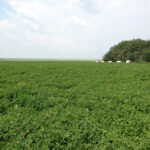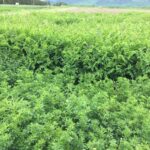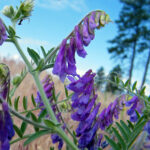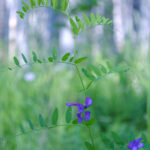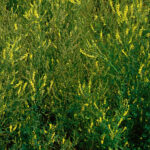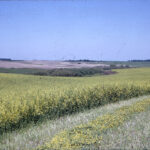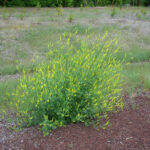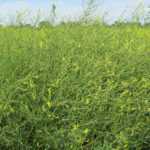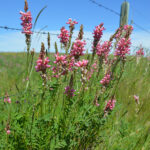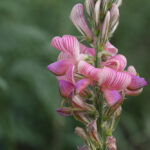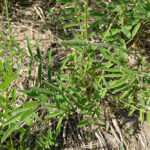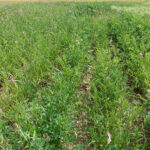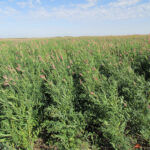White Clover
General Description
White clover requires adequate growing season moisture and moderate summer temperatures. White clover is widely distributed, especially in cool temperate climates. The plant has stolons or creeping stems near the soil surface. Leaves, flowers, and roots grow directly from these stolons. It is a relatively short plant with indeterminate growth, although taller types can grow up to 25 cm (10 in).
There are three types of white clover which vary mostly in height and persistence. The small type is commonly found in lawn mixes, or naturalized in disturbed or heavily grazed moist areas. It is highly persistent. The large type, often called Ladino, is larger (four-times) than the small type. With its low persistence it is rarely used, but can be seeded for short term hayland especially under irrigation. The intermediate type, also called common or Dutch, yields well, is a prolific seed producer, and is often used for pasture in high moisture regions.
White clover has 3 leaflets attached at a single point, and are dark green, often with a white watermark. Leaflets are finely toothed, hairless, and nearly round, up to 3 cm (1 1/4 in) wide. Plants are only as high as the length of the flower and leaf stocks, which varies by type from ground level 25 cm (10 in). Seedling plants develop a taproot initially and then as plants age they develop threadlike, fibrous roots growing from detached stolons. White clover can cause bloat.
White clover requires adequate growing season moisture and moderate summer temperatures. White clover is widely distributed, especially in cool temperate climates. The plant has stolons or creeping stems near the soil surface. Leaves, flowers, and roots grow directly from these stolons. It is a relatively short plant with indeterminate growth, although taller types can grow up to 60 cm (24 in).
There are three types of white clover which vary mostly in height and persistence (wild white, common white or white Dutch and Ladino). They look the same, but differ in size. Wild white clover is the smallest, ranging from 5-17.5 cm (2-7 in) tall. Intermediate white clover (also called Dutch or New Zealand White) grows to 40 cm (16 in). Ladino clover can grow up to 60 cm (24 in). The intermediate types are more suited for pastures than the ladino and tend to have more stolons per square metre than the ladino varieties.
White clover has 3 leaflets attached at a single point, and are dark green, often with a white watermark. Leaflets are finely toothed, hairless, and nearly round, up to 3 cm (1 1/4 in) wide. Plants are only as high as the length of the flower and leaf stocks, which varies by type. Seedling plants develop a taproot initially and then as plants age they develop threadlike, fibrous roots growing from detached stolons. White clover can cause bloat.
Type
Agronomic legume.
Origin
Mediterranean origins. Brought to North America by settlers.
Longevity
At least 10 years. Stolon survival and self-seeding (seed set) is critical for persistence.
Use
Intermediate types used for pasture. Small types tend to increase in continually grazed pastures.
Pasture. Intermediate types used for pasture. Small types tend to increase in continually grazed pastures.
Optimal Time of Use
Summer, fall. Late spring, once the plant has reached full height and leaf canopy, it is safe to begin use.
Recovery After Use
Tolerates frequent grazing and can be grazed repeatedly throughout the season to 5 cm (2 in) height. Intermediate and large types benefit from rotational grazing. Low growing points make small type white clover well adapted to use in continuous, closely grazed systems. Only graze lightly in the last six weeks of the growing season for improved winter survival.
Yield
The low growth form makes white clover lower yielding than other legumes, but quality remains high throughout the growing season and after grazing. Intermediate and tall types have greater forage yields.
Palatability/Nutritional Value
Excellent palatability, highly digestible. White clover crude protein is approximately 19.5-21% and total digestible nutrients is around 65%. Quality is maintained throughout the growing season as new leaves are grown. Can cause bloat. Sheep may select for white clover increasing their risk for bloat.
Annual Precipitation min/max (mm)
400mm / 1770mm.
Drought Tolerance
Poor tolerance. White clover is unproductive even in short duration drought. It easily dies from long or extreme drought. Small types tend to be more drought tolerant.
Poor tolerance. White clover is unproductive even in short duration drought. It easily dies from long or extreme drought. Small types tend to be more drought tolerant.
Flooding Tolerance
Tolerates 1-2 weeks of spring flooding. High moisture is desired over the growing season, but flooding or water logging is not tolerated.
Winter Hardiness
Poor to fair hardiness. Growing points are in the stolons which are at or on the soil surface so very susceptible to winter kill. Maintaining soil fertility and restricting grazing to light or no grazing in the last six weeks of the growing season improves winter survivability. Intermediate and small types have some winter hardiness while large types are the least winter hardy.
Soil Texture Preference
White clover prefers fertile clay and loam textured soil. White clover may grow on coarser sandier soils if moisture is adequate.
Erosion Control
Not well suited. White clover may be included in some erosion control mixtures as a nitrogen fixer for grasses or as a plant for higher moisture areas.
Salinity Tolerance
Not tolerant.
Acidity Tolerance
Moderate tolerance. White clover can grow in pH 5.0, but prefers 6.0 to 6.5.
Moderate tolerance. White clover can grow in pH 5.5, but prefers 6.0 to 6.5.
Alkalinity Tolerance
Low tolerance.
Seeds per kg
1,764,000 seeds/kg (800,000 seeds/lb)
Suggested Mixtures
White clover mixes well with most cool season perennial grasses, particularly bunch grasses that can tolerate frequent grazing allowing for an open canopy; meadow bromegrass, orchard grass, tall fescue. Has also been grown with Russian wildrye and timothy. White clover can compete with sod forming grasses such as Kentucky bluegrass, and smooth bromegrass when moisture and fertility are not limiting and frequent defoliation keeps the canopy open.
White clover mixes well with most cool season perennial grasses, particularly bunch grasses that can tolerate frequent grazing allowing for an open canopy; meadow bromegrass, orchard grass, tall fescue. Has also been grown with timothy. White clover can compete with sod forming grasses such as Kentucky bluegrass, and smooth bromegrass when moisture and fertility are not limiting and frequent defoliation keeps the canopy open.
Ease of Establishment
White clover should be seeded shallow (6 mm / 0.25 in). Although seedlings are small and slow to develop, they can establish easily if fertility and moisture conditions are favourable. Competition from grasses and cover crops should be minimized. Stand will thicken as stolons develop.
Competitiveness
Small volunteer types can invade continuously grazed pastures, especially under moist conditions. Healthy stolons are critical for competitiveness. Shading of white clover decreases its competitiveness.
Small volunteer types can invade continuously grazed pastures, especially under moist conditions. Healthy stolons are critical for competitiveness. Shading of white clover decreases its competitiveness. White clover roots generally grow to the same depth as roots of commonly used grasses, creating intense competition between white clover and the grasses for soil nutrients and moisture. White clover often disappears from pastures because it cannot compete with the grasses for nutrients present at low levels.
Management Considerations
It is important to monitor livestock for bloat while grazing white clover. Inoculate white clover with Rhizobium trifolii for better nodulation and nitrogen fixing. Grows best on fertile, moist soils without shading from other plants. Stolon survival is critical for persistence so maintaining adequate fertility is important. Although white clover can tolerate a shorter rest period than most other legumes in a grazing system, grazing should be light enough not to damage stolons. Restrict or reduce grazing in the last six weeks of the growing season to restore stolon health and provide a canopy to help insulate stolons for winter. White clover can be grazed after a killing frost, however, reducing the canopy increases the risk of winter kill.
It is important to monitor livestock for bloat while grazing white clover. Inoculate white clover with Rhizobium trifolii for better nodulation and nitrogen fixing. Grows best on fertile, moist soils without shading from other plants. Stolon survival is critical for persistence so maintaining adequate fertility is important. Although white clover can tolerate a shorter rest period than most other legumes in a grazing system, grazing should be light enough not to damage stolons. Restrict or reduce grazing in the last six weeks of the growing season to restore stolon health and provide a canopy to help insulate stolons for winter. White clover can be grazed after a killing frost, however, reducing the canopy increases the risk of winter kill.
British Columbia Rangeland Seeding Manual, Saskatchewan Dryland Forage Species Adaptation Tool, Manitoba Forage Adaptation and Comparison Guide, USDA Plants Database, Alberta Forage Manual
British Columbia Rangeland Seeding Manual, Saskatchewan Dryland Forage Species Adaptation Tool, Manitoba Forage Adaptation and Comparison Guide, USDA Plants Database, Alberta Forage Manual, OMAFRA Publication 30
White clover is adapted to the Sub-Boreal Spruce, Sub-Boreal Pine-Spruce and Interior Cedar-Hemlock zones. In the southern part of the Central Interior it is suited to wetter parts of the Interior Douglas-fir zone, and to irrigated and subirrigated areas in the Bunchgrass zone and dry parts of the Interior Douglas-fir zone. It will typically persist in swales and depressions in the drier zones, and the white Dutch types can be included to have benefits of a legume in dryland pasture mixes in wetter areas of the Interior Douglas-fir zone.
White clover is most suited to pasture use in the wetter areas in the region (i.e., the Interior Cedar-Hemlock Zone) and to irrigated or subirrigated areas in the higher elevation parts of the Bunchgrass zone, the Ponderosa Pine and Interior Douglas-fir zones. It will typically persist in swales and depressions in the drier zones, and the white Dutch types can be included to have benefits of a legume in dryland pasture mixes in more wetter areas of the Interior Douglas-fir zone.

